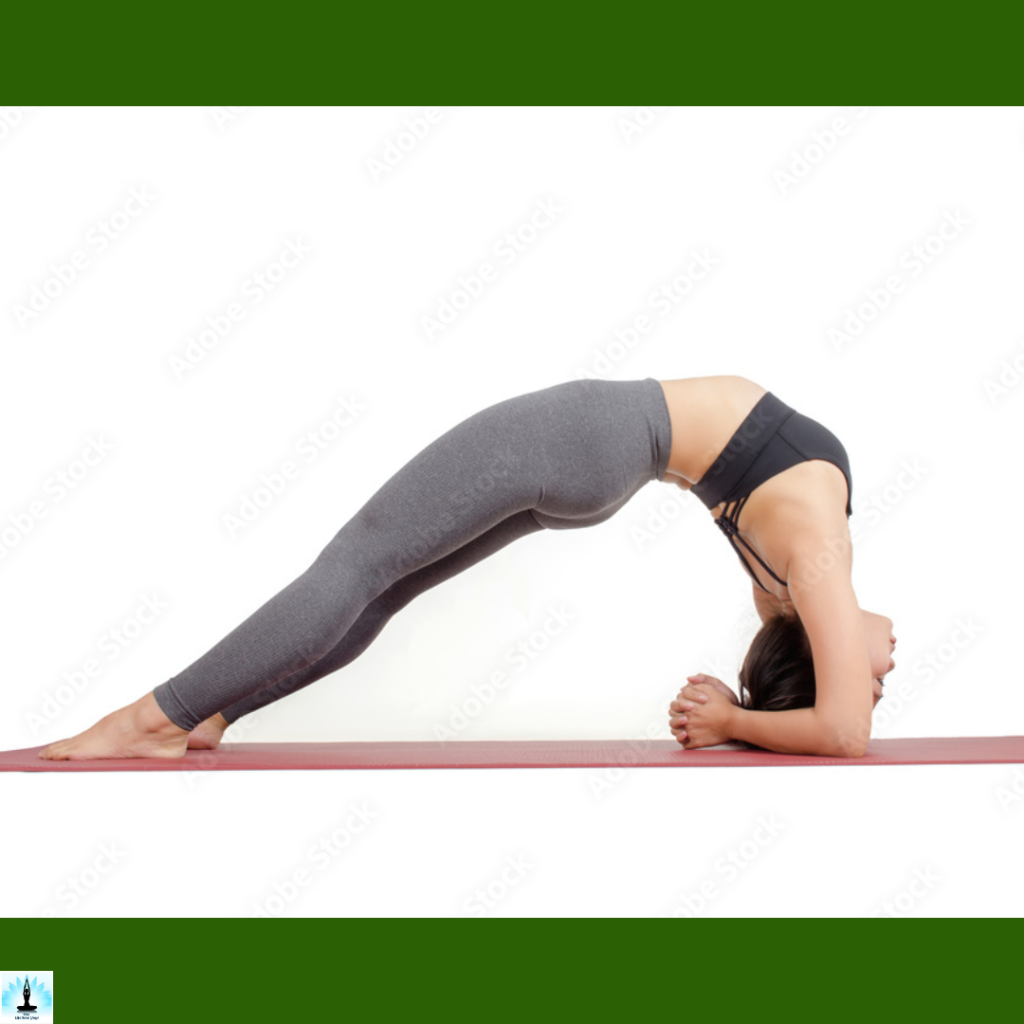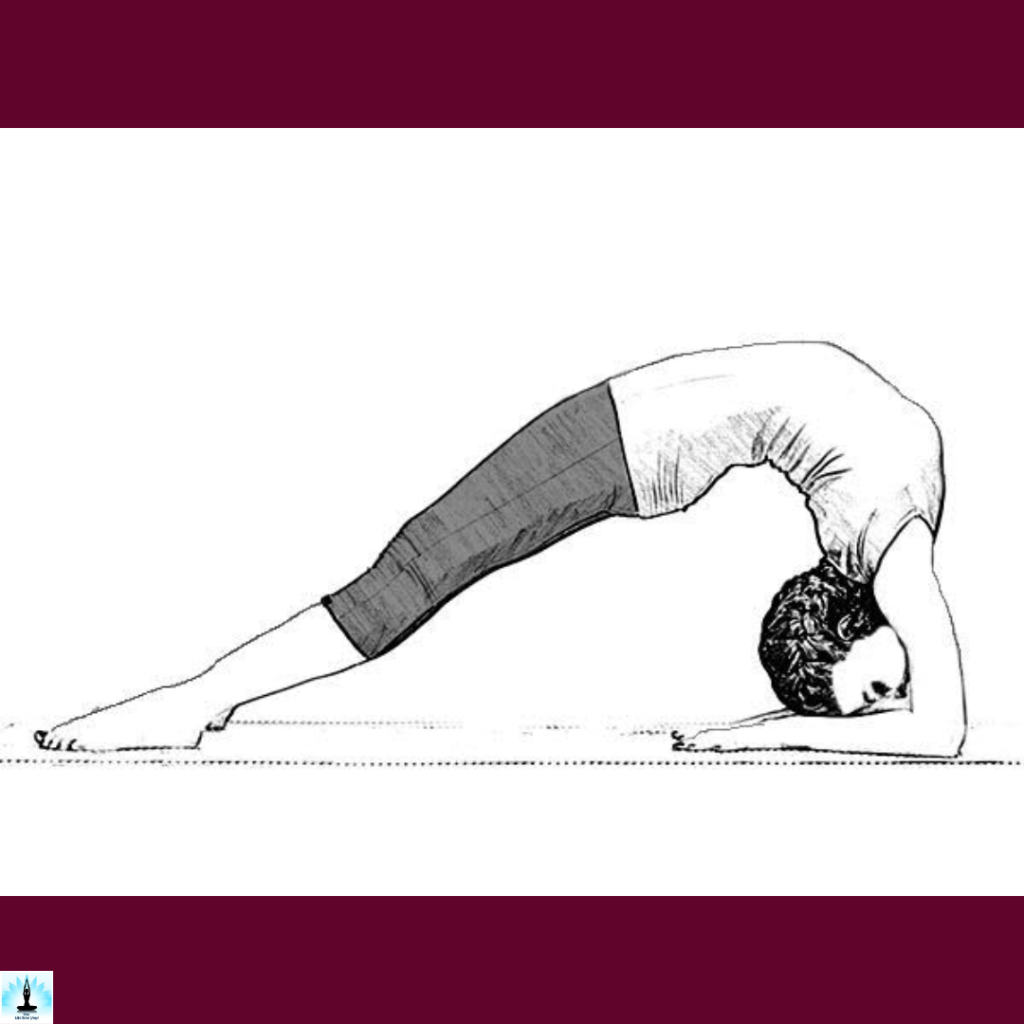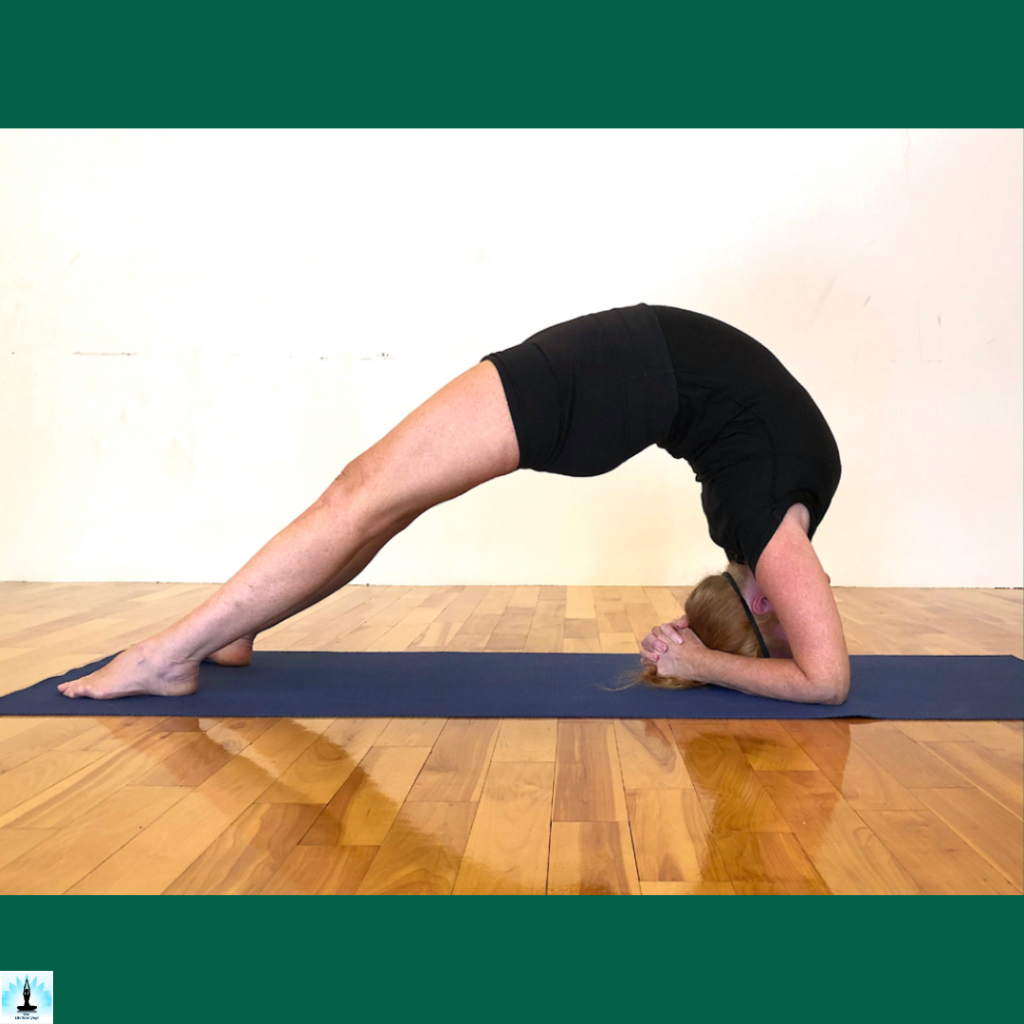Introduction – Top 7 Benefits of Viparita Dandasana
Viparita Dandasana, commonly known as Inverted Staff Pose, is a powerful and advanced yoga asana that combines elements of back bending, strength, and balance. This pose offers a multitude of physical, mental, and energetic benefits for those who have developed a strong foundation in yoga practice. Let’s delve into the intricacies of Viparita Dandasana, exploring its steps, benefits, precautions, and the profound impact it can have on one’s well-being.
Table of Contents
The Yogic Philosophy of The Viparita Dandasana

The Yogic Philosophy of Viparita Dandasana, or Inverted Staff Pose, is deeply rooted in the principles of balance, openness, and energy flow within the body. This advanced yoga posture combines the physical and spiritual aspects of yoga philosophy.
In Viparita Dandasana, the inversion aspect symbolizes a shift in perspective, encouraging practitioners to see the world from a different angle, both literally and metaphorically. The heart-opening nature of the pose aligns with the yogic philosophy of opening oneself to love, compassion, and connection.
As the chest expands and the spine flexes, the pose embodies the idea of breaking through limitations and barriers, fostering a sense of liberation. The engagement of core muscles represents the strength required to maintain balance, echoing the yogic principle of cultivating inner strength and resilience.
Significance of Viparita Dandasana
Viparita Dandasana is a backbending pose that requires considerable flexibility in the spine, shoulders, and strength in the core and legs. The name itself provides insights into the posture – “Viparita” translates to “inverted,” “Danda” means “staff” or “rod,” and “Asana” refers to “pose” or “posture.” This asana is often considered an intermediate to advanced level pose and is a variation of Dandasana (Staff Pose) taken to a deeper and inverted level.
7 Top Benefits of Viparita Dandasana
There are several benefits of Viparita Dandasana. Out of these, I have mentioned the top 7 of them.

Heart Opening:
Viparita Dandasana is a profound heart opener, expanding the chest and stretching the front of the body. This can lead to improved posture and increased feelings of openness.
Strengthens Core Muscles:
The pose engages the core muscles, including the abdominal muscles and lower back, promoting strength and stability in the torso.
Enhances Spinal Flexibility:
Practicing Viparita Dandasana helps increase flexibility in the spine, especially in the thoracic region. It encourages a healthy range of motion in the back.
Stimulates Digestive Organs:
The inversion in this pose can stimulate the digestive organs, potentially aiding in digestion and alleviating issues related to the gastrointestinal system.
Boosts Energy and Confidence:
The heart-opening nature of the pose is associated with an increase in energy levels and a sense of empowerment. It may help cultivate confidence and a positive mindset.
Therapeutic for Mild Depression:
Backbends are known for their mood-enhancing qualities. Viparita Dandasana, with its inversion and heart-opening components, can be therapeutic for mild depression and anxiety.
Develops Balance and Concentration:
Balancing on the forearms while inverted challenges stability and concentration. Regular practice can improve overall balance and focus.
Step-by-Step Instructions of Viparita Dandasana

Preparation:
Begin in a seated position with your legs extended in front of you (Dandasana). Place your hands behind your hips, fingers pointing forward, and press into the palms to lift your chest.
Shoulder Opening:
Bend your elbows and place your hands on the ground beside your hips. Walk your hands slightly back, allowing your chest to broaden, and lift your sternum.
Elbow Support:
Lower onto your forearms one at a time. Keep your forearms parallel to each other, and ensure your elbows are shoulder-width apart.
Lift the Hips:
Engage your core and press into your forearms as you lift your hips toward the ceiling. Keep your thighs and feet grounded, creating a diagonal line from your head to your heels.
Head Position:
Allow your head to hang freely or gently support it with your hands. Ensure your neck remains comfortable and doesn’t experience excessive strain.
Leg Engagement:
Keep your legs active and extended, with the weight evenly distributed between your hands and feet. Point your toes and engage your quadriceps.
Breathing:
Maintain smooth and deep breaths. Focus on expanding the chest and opening the heart center as you hold the pose.
Hold the Pose:
Hold Viparita Dandasana for a duration that feels comfortable, gradually increasing the time as your strength and flexibility improve.
Release:
To exit the pose, gently lower your hips to the mat and extend your legs forward. Take a moment to sit quietly and observe the effects of the inversion.
Advance Variations of Viparita Dandasana
Viparita Dandasana, or Inverted Staff Pose, is already an advanced yoga posture, but for those seeking an additional challenge and a deeper exploration of their practice, there are advanced variations to consider.
- One such variation involves transitioning into the pose from an advanced backbend, such as Urdhva Dhanurasana (Wheel Pose). This seamless flow demands increased flexibility, strength, and control.
- Another advanced variation introduces leg variations, where one leg extends straight up towards the ceiling while the other remains grounded, intensifying the stretch and balance requirements.
- For the boldest practitioners, attempting Viparita Dandasana with a single arm support adds an extra layer of difficulty, demanding exceptional core stability and shoulder strength.
Therapeutic Applications of Viparita Dandasana
Viparita Dandasana offers therapeutic benefits that extend beyond the physical realm, promoting overall well-being.
As a heart-opening inversion, the pose stimulates the circulatory and respiratory systems, enhancing blood circulation and oxygenating the body. This can be beneficial for individuals dealing with mild depression or anxiety, as inversions are known to uplift mood and alleviate stress.
The gentle stretch across the chest and abdomen helps relieve tension in the thoracic spine, making Viparita Dandasana therapeutic for those with mild back discomfort or stiffness. The pose’s inversion aspect can also have a soothing effect on the nervous system, promoting relaxation and reducing fatigue.
Poses Related to Viparita Dandasana
Viparita Dandasana, or Inverted Staff Pose, is a challenging yoga posture that beautifully complements and integrates with various other poses, creating a well-rounded practice.
Preparatory Poses of Viparita Dandasana
When aiming to cultivate strength and flexibility, incorporating preparatory poses like Setu Bandhasana (Bridge Pose) and Urdhva Mukha Svanasana (Upward-Facing Dog) can help warm up the spine, shoulders, and hip flexors.
For those seeking to deepen their backbending practice, incorporating poses like Ustrasana (Camel Pose) and Dhanurasana (Bow Pose) can be beneficial. These poses encourage spinal extension and enhance the flexibility required for a successful Viparita Dandasana.
Follow-up Poses of Viparita Dandasana
As inversions play a key role in Viparita Dandasana, follow-up poses like pairing it with other inversions like Sirsasana (Headstand) or Sarvangasana (Shoulder Stand) can create a synergistic effect, promoting improved circulation and enhancing the inversion experience.
Balancing poses such as Ardha Chandrasana (Half Moon Pose) or Virabhadrasana III (Warrior III) can further refine stability and concentration, prerequisites for mastering Viparita Dandasana.
Beginner’s Tip of Viparita Dandasana
As a beginner requires a thoughtful approach to ensure a safe and fulfilling experience. Begin by establishing a strong foundation in preparatory poses that focus on building flexibility in the spine, shoulders, and hip flexors.
Setu Bandhasana (Bridge Pose) and gentle backbends serve as excellent stepping stones to develop the necessary mobility.
When transitioning into Viparita Dandasana, use props like a yoga block or bolster to support the upper back and shoulders, allowing the chest to open gradually.
Contraindications and Cautions of Viparita Dandasana
While Viparita Dandasana offers numerous benefits, it is essential to approach it with caution, especially if you have specific health concerns or conditions. Consider the following precautions:
Avoid if Pregnant:
Pregnant individuals should avoid inversions and intense backbends. Always consult with a healthcare provider before attempting advanced yoga poses during pregnancy.
Wrist and Shoulder Issues:
Individuals with wrist or shoulder injuries may need modifications or should avoid putting excessive weight on the arms. Consider consulting with a yoga teacher or healthcare professional for guidance.
Neck Sensitivity:
If you have neck issues or discomfort, be mindful of the head position. Keep the neck in a neutral and comfortable position, and avoid straining.
High Blood Pressure:
Inversions may affect blood pressure, so those with high blood pressure should approach this pose cautiously. It’s advisable to consult with a healthcare professional before attempting inversions.
Spinal Conditions:
Individuals with spinal issues or conditions should approach backbends and inversions with care. Consider seeking guidance from a qualified yoga teacher or healthcare provider.
Frequently Asked Questions (FAQs) on Viparita Dandasana: Exploring the Inverted Staff Pose
Q1: What Are the Key Benefits of Practicing Viparita Dandasana?
A1: Viparita Dandasana offers a myriad of benefits, including increased flexibility in the spine, strengthened core muscles, improved circulation, and a heart-opening experience that uplifts mood and reduces stress.
Q2: Can Beginners Attempt Viparita Dandasana?
A2: While Viparita Dandasana is an advanced pose, beginners can gradually approach it with proper preparation and under the guidance of an experienced teacher. Modifications and props can be used to support the practice.
Q3: How Does Viparita Dandasana Contribute to Emotional Well-Being?
A3: The heart-opening nature of Viparita Dandasana stimulates the circulatory and respiratory systems, fostering emotional well-being by uplifting mood, reducing mild depression or anxiety, and promoting relaxation.
Q4: Are There Any Contraindications for Viparita Dandasana?
A4: Individuals with back injuries, high blood pressure, or neck issues should approach Viparita Dandasana with caution. It’s advisable to consult with a healthcare professional or yoga instructor before attempting the pose.
Q5: Can Viparita Dandasana Be Included in A Regular Yoga Sequence?
A5: Yes, Viparita Dandasana can be integrated into a comprehensive yoga practice. It complements backbends, inversions, and balancing poses, contributing to a holistic approach to strength, flexibility, and mental focus.
Q6: How Can One Progress into Advanced Variations of Viparita Dandasana?
A6: Gradual progression, mindful practice, and seeking guidance from experienced teachers are key to advancing in Viparita Dandasana. Advanced variations may involve transitioning from backbends or incorporating single-arm support.
Q7: Are There Specific Preparations for Viparita Dandasana?
A7: Yes, preparatory poses play a crucial role in getting the body ready for the demands of Viparita Dandasana. Backbends like Setu Bandhasana and Urdhva Mukha Svanasana help warm up the spine and shoulders, creating a foundation for a successful Inverted Staff Pose.
Q8: Can Viparita Dandasana Be Therapeutic for Certain Conditions?
A8: Indeed, Viparita Dandasana offers therapeutic benefits. The inversion aspect can alleviate mild back discomfort and promote relaxation in the nervous system, making it potentially beneficial for those dealing with stress, anxiety, or mild depression.
Q9: How Does Viparita Dandasana Contribute to The Development of Balance?
A9: While primarily a backbend, Viparita Dandasana requires a degree of balance and stability. Incorporating balancing poses like Ardha Chandrasana or Virabhadrasana III in the practice can further enhance these aspects, creating a harmonious blend in one’s yoga journey.
Conclusion
Viparita Dandasana is a transformative yoga pose that combines strength, flexibility, and inversion. While it offers a myriad of benefits, it’s crucial to approach this pose mindfully, especially if you are a beginner or have specific health considerations. Consider seeking guidance from an experienced yoga teacher to ensure proper alignment and modifications tailored to your individual needs. As with any yoga practice, listen to your body, respect your limitations, and enjoy the journey of exploration and self-discovery on the mat.
References
- Mehta 1990, pp. 136–137.
- ^ Iyengar 1979, pp. 378–379.
- ^ Iyengar 1979, p. 379.
- Iyengar, B. K. S. (1979) [1966]. Light on Yoga: Yoga Dipika. Unwin Paperbacks. ISBN 978-1855381667.
- Mehta, Silva; Mehta, Mira; Mehta, Shyam (1990). Yoga: The Iyengar Way. Dorling Kindersley.
- Sjoman, Norman E. (1999) [1996]. The Yoga Tradition of the Mysore Palace. Abhinav Publications. ISBN 81-7017-389-2.
